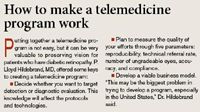Article
Telemedicine for overlooked retinopathy in diabetes
A telemedicine program, in which images allow patients to virtually visit with doctors, can be a valuable tool in the early detection, management, and treatment of diabetic retinopathy.

Key Points
Hong Kong-With diabetes cases worldwide expected to double in the first 30 years of the 21st century, telemedicine might be a pathway to ensuring that more patients receive care that prevents complications from retinopathy, said P. Lloyd Hildebrand, MD, assistant professor of ophthalmology, Dean A. McGee Eye Institute, Oklahoma University Health Sciences Center, Oklahoma City.
Telemedicine uses digital imaging to help patients "visit" with physicians. Patients can be seen live via video by their providers, or their virtual visit can be recorded and stored for a provider to view at a later date.
"Remote retinal imaging with centralized interpretation allows for increased access, quality, and efficiency," Dr. Hildebrand said in a presentation at the World Ophthalmology Congress.
"Diabetes care is primarily given by primary care physicians," he said. "But diabetic patients' eyes need to be evaluated by an ophthalmologist when they're asymptomatic. Because of that, many patients fall out of the system between the primary care physician's office and the ophthalmologist's office."
According to Dr. Hildebrand, if the care can be brought closer to the patients, and if reliable tests can be done remotely that can identify the people at risk for vision loss caused by diabetic retinopathy, it offers a "better mousetrap" to identify the patients at risk and get them into treatment.
Back-seat symptom
One reason the eyes often take a back seat in diabetes care is that many diabetic patients have so many different problems, such as high and low blood sugar levels, foot ulcers, and cardiac problems, that the asymptomatic concerns aren't treated adequately. In many cases, the eye care portion of diabetes care doesn't get taken care of until patients start to lose vision-which is a suboptimal treatment time.
"However, if we identify patients at risk early and get them into treatment, we certainly have very effective treatments with laser photocoagulation and some of the new anti-VEGF (vascular endothelial growth factor) drugs," Dr. Hildebrand said.
The eyes often are considered later rather than earlier in diabetes treatment plans. It actually makes good sense to pay early close attention to the eyes, however, because they offer a "window" into the microvascular system, in that the blood vessels in the eye directly can be seen by looking at the retina.
"The one part of the human body where we can directly visual the vascular system is in the retina," he said. "That helps primary care physicians determine what's happening in patients' kidneys, coronary vessels, brains, and feet. You can actually see direct changes in the blood vessels by looking at the retina."
Getting primary care physicians to give greater priority to eye care in their diabetic patients takes education of both physicians and patients. Dr. Hildebrand's program uses a series of posters, mailings to patients, educational seminars conducted in primary care physicians' offices, and teaching guides that help family physicians, internal medicine practitioners, and endocrinologists educate their patients about the importance of eye care.
"We try to put some tools in their hands so they can start to emphasize the eye disease," Dr. Hildebrand said. "It's important to make the program work for the physicians. This has to be something that's convenient for them, that doesn't disrupt their workflow, and can provide them with good information so they can help their patients make good decisions."

"It's easy to take pictures of one patient and get a technologist to do that. It's a lot different if you start doing hundreds of thousands," Dr. Hildebrand said. "You must determine not only how to get it done, but how to maintain quality assurance and consistency through the whole process, and the whole system of care. It's not just about technology, it's how you build a complete solution."
Newsletter
Don’t miss out—get Ophthalmology Times updates on the latest clinical advancements and expert interviews, straight to your inbox.




